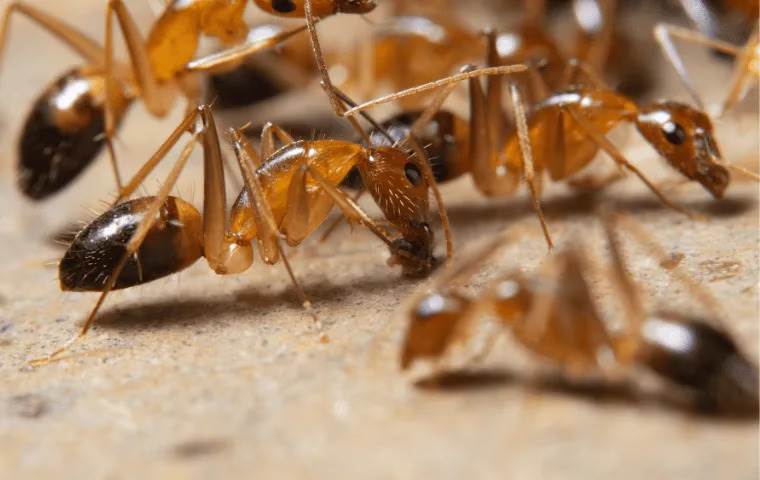
Ghost Ant Identification in Florida
Identifying Ghost Ants in Florida

In Florida's sunny climate, ghost ants are more than just a nuisance. These tiny invaders, no larger than 1.5 millimeters, blend in with their nearly invisible, pale bodies. This guide provides practical steps to spot these elusive ants in your home and effective tactics to manage their infestations.
Key Takeaways
- Identify ghost ants by their tiny size (1.3 to 1.5 mm) and unique color pattern — dark head and thorax with a pale, almost transparent abdomen.
- Be alert to indicators of infestation, such as small trails along walls or tiny ants near food sources and moisture areas.
- Regularly inspect and seal potential entry points and maintain cleanliness to deter these elusive pests.
- Utilize sugar or protein-based baits for active infestations, and consider professional pest control for more severe cases.
Identifying a Ghost Ant Infestation
While small and pale, ghost ants can be a significant nuisance in homes, especially kitchens and bathrooms. Here’s how to identify their presence:
- Foraging Workers: The most apparent sign of a ghost ant infestation is seeing these ants actively foraging. They’re particularly attracted to sweet, sugary substances and often gather near sinks and other moisture sources. Watch for these tiny ants on countertops, cabinets, or nearby kitchen appliances.
- Ant Trails: Ants are known for creating visible trails as they move along walls, baseboards, and under carpets to find food and water. Spotting these trails is a clear indication of their activity in your home.
- Food Contamination: Ghost ants seek and contaminate open food sources. So finding these ants in your pantry or near your food storage is a sign of infestation.
- Persistent Presence: Even after thorough cleaning, if you continue to see ghost ants, it suggests a larger, hidden infestation, possibly in wall voids or other concealed areas.
Ghost Ant Biology and Behavior
Ghost ants (tapinoma melanocephalum) are intriguing for their tiny size and elusive nature, typically measuring about 1.3 to 1.5 millimeters and displaying a pale, almost transparent appearance. Their bodies are distinctly segmented with a darker head and thorax, contrasting their lighter abdomen.
Some interesting facts are:
- Ghost ant colonies house thousands, featuring a caste system with queens, workers, and males. The queens are crucial for laying eggs and establishing new colonies.
- The presence of multiple queens within a single colony (similar to pharaoh ants), which can lead to rapid expansion and even the formation of supercolonies.
These ants exhibit sneaky nesting behaviors, often choosing locations like soil and rotting wood outdoors or wall voids and baseboards indoors.
These ants also have a diverse diet, including:
- Honeydew from Aphids: Ghost ants engage in symbiotic relationships with aphids to access the honeydew these insects produce.
- Diverse Insects: They consume small insects, like dead ants and termites, for protein. It’s not their first pick, but as omnivores, they make do with what they find.
Their foraging extends to household items like sugar, syrups, and greasy substances. In outdoor settings, ghost ants often search for these food sources among vegetation, grass, and tree branches.
Ghost Ant Habitats and Causes
In warm climates like Florida, Hawaii, and parts of Africa, ghost ants are known for their adaptability to various environments. Their nesting choices are closely linked to the availability of moisture and food:
- Indoor Preferences: Ghost ants seek out moist and hidden spots within homes, favoring areas like under sinks, damp corners, wall voids, and foundation cavities. These locations offer the dual advantage of proximity to water and food sources, making them ideal for ghost ants to establish their nests.
- Outdoor Habitats: In outdoor settings, ghost ants prefer grassy areas, dense vegetation for cover, and structural nooks in buildings for safety. These habitats provide protection and easy access to food, such as aphids in vegetation and potential entry points into indoor spaces.
Their nesting behavior, both indoors and outdoors, reflects their quest for safety and access to food and water. Essentially, they choose habitats that support their life cycle and growth process.
Preventing and Eliminating Ghost Ant Infestations
Diligence and smart strategies are key to keeping ghost ants at bay effectively. Here’s how you can fortify your home against these elusive invaders:
- Inspect and Seal Exteriors: Regularly check the outside of your home for openings. Sealing cracks and gaps can significantly hinder their entry.
- Maintain Indoor Cleanliness: Focus on keeping your home clean. Sweep away crumbs, wipe up spills, and store sweet foods securely.
- Manage Moisture: Fix leaks and improve air circulation to reduce indoor humidity, a major draw for ghost ants.
But if you’re facing a sure invasion, these are your main go-to steps:
- Deploy Baits: Utilize sugar-based or protein-based baits effectively, placing them near active ant areas.
- Professional Help: For larger or stubborn infestations, consider pest control services. They can offer thorough assessments and customized treatments to resolve the issue.
Adopting these steps not only curbs current infestations but also serves as a long-term deterrent, ensuring your home remains a sanctuary free from ghost ant invasions.
Frequently Asked Questions
How can I identify ghost ants?
Ghost ants, a specific type of ant, are tiny (1.3 to 1.5 mm) with a pale coloration, featuring a darker head and thorax. Their semi-transparent legs, antennae, and abdomen can make them challenging to spot. They are commonly seen in diverse environments, including greenhouses and homes.
What are the main characteristics of ghost ants?
As a unique ant species, ghost ants are adaptable and can establish colonies in various environments. They create nesting sites in soil, tree bark, and indoor spaces like flowerpots. Worker ants in these colonies play vital roles in maintaining their sub-colonies.
How do ghost ants differ from other species, like fire ants and carpenter ants?
Ghost ants are smaller and differ in diet and habitat compared to other species like fire ants, which have stingers, and carpenter ants, which are attracted to wood. Ghost ants prefer sweet substances, while others may feed on dead insects or other materials.
Can ghost ants cause any harm?
They don’t bite or sting like some ant species but can contaminate food. Their presence in homes, particularly in kitchens and near flowerpots or mulch, can lead to large infestations and an ant problem that requires pest management.
What attracts ghost ants to a home?
Their search for food, water, and shelter brings them to homes. They are especially attracted to sugary and greasy substances, and their nests are often found in moist areas. Proper ant control includes using repellents and ant baits.
How can I recognize a ghost ant infestation?
To identify a ghost ant infestation, watch for tiny, pale ants actively foraging for food. Persistent sightings of these ants, even after thorough cleaning, indicate an infestation. Also, finding ant nests in soil, indoor crevices, or hidden areas is a clear sign.
For effective pest management and removal of ghost ants, consider using targeted insecticides or seek assistance from professional pest control experts.

Why Choose Native Pest Management?
We Exceed Customer Expectations
-
Pet Friendly & Environmentally ConsciousNative Pest Management applies our pest control products with the safety of your family and pets in mind! We also offer eco-friendly pest control to protect your family and the planet.
-
Local Service ProfessionalsSince 2015, we have served communities in West Palm Beach and all throughout South Florida. Our team is fully licensed, insured, and vetted.
-
On TimeOur team will not only arrive on time, but they’ll also go above and beyond when providing service. It’s what makes us one of the top rated pest control companies in Florida! We strive for complete customer satisfaction every time.
-
Get a 100% Free Estimate
Whether you currently have pests in your home or simply want to start professional pest prevention, take the first step to a pest-free life, and contact us today for your free pet-friendly pest control quote.
-
“Warren took his time with the servicing and was very knowledgeable! Exceptional customer service. I will be requesting him each time.”- Montiea Singletary
-
“Excellent service by Chino from Native Pest Management. Chino went above and beyond to make sure we understood everything about the service and kept us very informed during the process.”- Brand Gonzalez
-
“Truly professionals at what they do. very respectful very knowledgeable and great attitude.”- Jorge Acosta
-
“I called and spoke to the manager, who was polite and courteous, and even though it cost them money to come back out and spray, they did not charge me again, and I was very thankful.”- S. Williams
-
“Dale is the absolute best in the business of pests! My sister and I personally ask for him every single time because he always goes above and beyond.”- Zariah Graham
-
“The technician was very professional. He explained things thoroughly and put me at ease with what was about to happen in my home.”- Anthony Diaz
-
“Native pest management always exceeds my expectations! The people who answer the phone are so nice and accommodating and make scheduling a breeze! The techs are always so nice and do a great job.”- Michelle Cato
-
“Extremely impressed with the technicians I met today. Tony and Jamie. Very thorough and customer oriented. I am expecting great things for my trees and plants.”- Curt Kredo

Native Pest Management's Blog
Want all the latest news or updates? Browse through our blog to read our most recent posts and featured articles.







